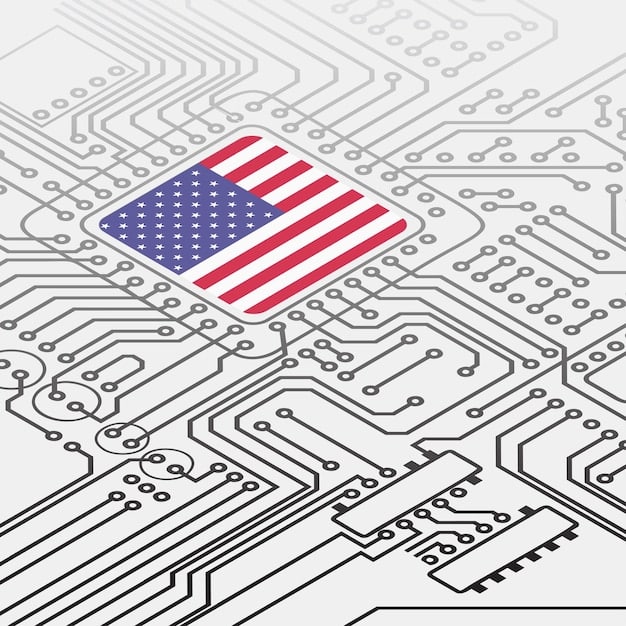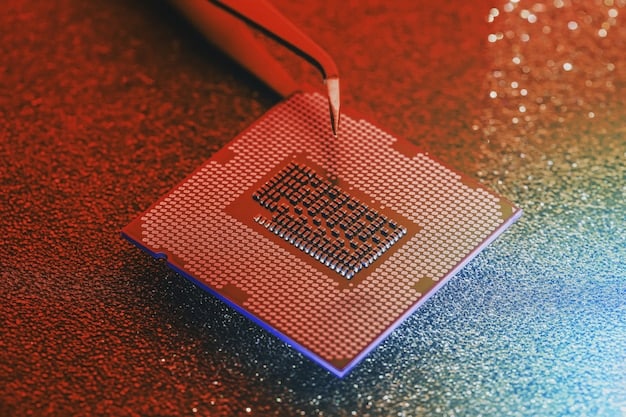US Commerce Dept. Imposes New Export Controls: Impact on Tech

The US Department of Commerce has announced new export controls on advanced computing technologies, marking a significant shift with far-reaching implications for the technology industry, both domestically and internationally.
The technology landscape has been dealt a significant hand with the recent announcement from the US Department of Commerce Announces New Export Controls on Advanced Computing Technologies. This move is poised to reshape how companies operate, innovate, and compete in the global market.
Understanding the New Export Controls
The US Department of Commerce’s recent announcement regarding new export controls on advanced computing technologies has sent ripples throughout the technology sector. Understanding the specifics of these controls is crucial for businesses to adapt and comply.
Specific Technologies Targeted
The new regulations focus on specific advanced computing technologies. These are not broad strokes; they represent a targeted approach aimed at curbing access to technologies considered vital for national security.
- Semiconductors and microchips designed for AI applications.
- Advanced manufacturing equipment used in chip production.
- Quantum computing technologies and related components.

These controls also extend beyond hardware. The Department of Commerce is scrutinizing software and algorithms used in AI, particularly those with potential military or surveillance applications. The goal is to prevent these technologies from falling into the wrong hands, restricting their use in activities that could undermine US national security or foreign policy interests. Companies must now conduct thorough due diligence to ensure compliance, understanding that the scope of these regulations is broad and subject to interpretation.
The regulations also impact the transfer of technical knowledge. US citizens or permanent residents are now generally prohibited from supporting the development or production of covered items in China and other targeted countries. This is particularly impactful for international collaborations and the globalization of research and development in advanced technologies.
In conclusion, the new export controls represent a comprehensive effort to restrict the flow of key technologies. They present both challenges and opportunities, requiring businesses to navigate a new regulatory landscape while continuing to foster innovation and growth.
Rationale Behind the Export Controls
The US Department of Commerce has implemented these export controls with specific objectives in mind. Understanding those objectives is crucial to understanding the reasoning behind limiting the export of advanced computing tech.
The primary justification for these export controls revolves around national security. Advanced computing technologies, particularly in areas like artificial intelligence and quantum computing, are seen as critical to maintaining a technological advantage over strategic competitors.
- Preventing foreign military advancements.
- Protecting intellectual property and innovation.
- Ensuring supply chain security for critical components.
Geopolitical Considerations

Geopolitical considerations also play a significant role. The US aims to prevent certain countries from acquiring technologies that could be used to enhance their military capabilities or engage in activities that threaten international stability.
These export controls seek to safeguard US technological leadership, promote fair competition, and protect national security interests. The implications of this move are far-reaching, impacting global supply chains, international collaborations, and the overall trajectory of technological innovation. These export decisions are not made lightly, and they reflect a broader strategy to ensure the long-term competitiveness and security of the United States.
In effect, the rationale behind the export controls is complex, interweaving economic, security, and geopolitical considerations. Businesses operating in the technology sector must recognize these underlying drivers to effectively navigate the new regulatory environment.
Impact on the Semiconductor Industry
The semiconductor industry, a cornerstone of the modern economy, stands to be significantly impacted by these new export controls. These regulations could potentially influence market dynamics and the strategies of semiconductor companies worldwide.
One of the immediate effects of the export controls is a potential disruption to global supply chains. Semiconductor manufacturing is a complex process, with various stages often spread across different countries.
Increased Compliance Burdens
The new regulations will undoubtedly increase the compliance burden for semiconductor companies. These companies must now implement robust systems to monitor and control the export of their products, ensuring they do not violate the restrictions.
Companies may face:
- Extensive audits and reporting requirements.
- Increased costs associated with compliance measures.
- Potential delays in shipments and transactions.
For smaller companies with limited resources, the compliance burden could be particularly challenging, potentially hindering their ability to compete effectively.
Moreover, the export controls could incentivize companies to diversify their supply chains and reduce their reliance on specific markets or suppliers. This could lead to increased investment in domestic manufacturing capabilities in the US and other countries, promoting regionalization and reducing vulnerability to geopolitical risks.
Overall, the impact on the semiconductor industry is multifaceted, presenting both challenges and opportunities. Companies that can adapt quickly, strengthen their compliance capabilities, and diversify their operations are likely to thrive in this new regulatory environment.
Effects on AI and Quantum Computing
Artificial Intelligence (AI) and Quantum Computing are pivotal sectors that will experience substantial effects from the new export controls. Their innovative breakthroughs and potential applications make them the central focus of these regulations.
The export restrictions are likely to affect the pace of AI development, especially in areas that rely on advanced computing hardware. AI algorithms, particularly those used in deep learning and neural networks, require powerful processors and massive amounts of data for training.
Potential for Innovation Slowdown
The export controls could slow down the pace of innovation in certain areas of AI. Limiting access to advanced computing hardware could restrict the ability of researchers and developers to experiment with new algorithms and architectures.
- Reduced access to cutting-edge hardware.
- Challenges in training complex AI models.
- Potential delays in commercializing AI applications.
The quantum computing sector, still in its early stages of development, faces unique challenges under the new export controls. Export restrictions could hinder international collaborations and slow down the overall progress of quantum computing technology.
However, the export controls are not without potential benefits. They could incentivize the US and other countries to invest more heavily in domestic AI and quantum computing capabilities.
In summary, the effects on AI and quantum computing are complex, with potential impacts on innovation, collaboration, and investment, but also promoting domestic capabilities.
Strategies for Companies to Adapt
Given the breadth and depth of the export controls, companies must adapt proactively to mitigate potential disruptions and remain competitive.
One of the first steps companies should take is to conduct a thorough assessment of their current operations. This assessment should identify areas that may be affected by the new export controls and evaluate the potential risks and vulnerabilities.
Strengthening Compliance Programs
Companies must strengthen their compliance programs to ensure they are fully compliant with the new export controls. This includes implementing robust systems to monitor and control the export of their products.
Key elements of a strong compliance program include:
- Regular training for employees on export control regulations.
- Enhanced screening processes for customers and transactions.
- Automated systems to track and manage exports.
Companies can also benefit from diversifying their supply chains to reduce their reliance on specific markets or suppliers. By sourcing components and materials from multiple locations, companies can mitigate the risk of disruptions caused by export controls or other geopolitical events.
Moreover, companies should consider investing in research and development to develop alternative technologies or processes that are not subject to export controls.
In conclusion, adapting to the new export controls requires a comprehensive and proactive approach. By strengthening their compliance programs, diversifying their supply chains, and investing in R&D, companies can navigate the new regulatory landscape and remain competitive.
Global Implications and Responses
The US Department of Commerce’s export controls are likely to have significant global implications, prompting responses from other countries and international organizations.
Other countries may implement their own export controls or trade restrictions in response to the US measures. This could lead to further fragmentation of the global technology market.
It is possible that some countries may challenge the US export controls through the World Trade Organization (WTO) or other international forums.
Impact on International Collaborations
The export controls could also impact international collaborations in science and technology. Researchers and institutions may face restrictions on sharing information or transferring technology to certain countries.
This could lead to:
- Reduced collaboration on joint projects.
- Increased barriers to technology transfer.
- Potential brain drain from affected countries.
Some countries may seek to develop their own domestic capabilities in advanced computing technologies to reduce their reliance on foreign suppliers. This could lead to increased investment in R&D and manufacturing in countries like China, India, and the European Union.
Overall, the global implications are complex and far-reaching. The responses from other countries and international organizations will shape the future of the technology industry and the global balance of power.
| Key Point | Brief Description |
|---|---|
| 🛡️ Export Controls | US Dept. of Commerce implements new export controls on advanced computing technologies. |
| 🎯 Targeted Tech | Focus on semiconductors, AI, and quantum computing to protect national security. |
| 🌐 Global Impact | Potential disruptions to supply chains and responses from other countries. |
| 📈 Adaptation | Companies must strengthen compliance, diversify supply chains, and invest in R&D. |
Frequently Asked Questions (FAQ)
▼
The export controls primarily target advanced computing technologies, including semiconductors designed for AI, advanced manufacturing equipment for chip production, and quantum computing technologies.
▼
The US implemented these controls to protect national security, prevent foreign military advancements, safeguard intellectual property, and ensure supply chain security for critical components in technology.
▼
The semiconductor industry may face disruptions to global supply chains, increased compliance burdens, potential shipment delays, and higher costs associated with meeting the new regulatory requirements.
▼
Companies must strengthen compliance programs, diversify supply chains to reduce reliance on specific markets, and invest in research and development to develop alternative technologies and processes.
▼
Other countries may implement their own export controls, challenge the US measures through international organizations, or invest in domestic capabilities to reduce reliance on foreign suppliers due to collaborations.
Conclusion
In conclusion, the US Department of Commerce Announces New Export Controls on Advanced Computing Technologies presents a complex landscape of challenges and opportunities. Companies that proactively adapt, strengthen compliance, and strategically innovate will be best positioned to thrive in this evolving environment.





